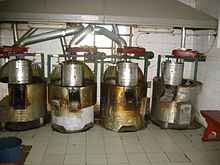


Pumpkin seed oil is a culinary oil, used especially in eastern Europe.



Pumpkin seed oil is a culinary oil, used especially in eastern Europe.
This oil is a culinary specialty from what used to be part of the Austro-Hungarian Empire and is now southeastern Austria (Styria), eastern Slovenia (Styria and Prekmurje), Central Transylvania, Orăștie-Cugir region of Romania, north western Croatia (esp. Međimurje), Vojvodina, and adjacent regions of Hungary. It is also used worldwide, including North America, Mexico, India and China. [1]
Pumpkin seed oil has an intense nutty taste and is rich in polyunsaturated fatty acids. Browned oil has a bitter taste. Pumpkin seed oil serves as a salad dressing. The typical Styrian dressing consists of pumpkin seed oil and cider vinegar. The oil is also used for desserts, giving ordinary vanilla ice cream a nutty taste. It is considered a delicacy in Austria and Slovenia, and a few drops are added to pumpkin soup and other local dishes. Using it as a cooking oil, however, destroys its essential fatty acids. [2]
Oil from pumpkin seeds is extracted by solvent extraction or by supercritical carbon dioxide methods. [3] Once the oil is obtained, further specific extractions may be done, such as for carotenoids. [3]
Styrian oil – an export commodity of Austria and Slovenia – is made by pressing roasted, hull-less pumpkin seeds from a local variety of pumpkin, the "Styrian oil pumpkin" ( Cucurbita pepo subsp. pepo var. 'styriaca', [4] [5] also known as var. oleifera). High-temperature roasting improves the aromatic quality of pumpkin seed oil. [6]

The viscous oil is light to very dark green to dark red in colour depending on the thickness of the observed sample. The oil appears green in thin layers and red in thick layers, an optical phenomenon called dichromatism. [7] Pumpkin seed oil is one of the substances with the strongest dichromatism. Its Kreft's dichromaticity index is −44. [8] When used together with yoghurt, the oil turns bright green and is sometimes referred to as "green-gold".
Other types of pumpkin seed oil are also marketed worldwide. International producers use white seeds with shells and this produces a cheaper white oil. New producers of seeds are located in China.
An analysis of the oil extracted from the seeds of each of twelve cultivars of C. maxima , related, yet different pumpkin species, yielded the following ranges for the percentage of several fatty acids: [9]
| n:unsat | Fatty acid name | Percentage range |
|---|---|---|
| (14:0) | Myristic acid | 0.09–0.27 |
| (16:0) | Palmitic acid | 12.6–18.4 |
| (16:1) | Palmitoleic acid | 0.12–0.52 |
| (18:0) | Stearic acid | 5.1–8.5 |
| (18:1) | Oleic acid | 17.0–39.5 |
| (18:2) | Linoleic acid | 36.2–62.8 |
| (18:3) | Linolenic acid | 0.34–0.82 |
| (20:0) | Arachidic acid | 0.26–1.12 |
| (20:1) | Gadoleic acid | 0–0.17 |
| (22:0) | Behenic acid | 0.12–0.58 |
The sum of myristic and palmitic acid content ranged from 12.8 to 18.7%. The total unsaturated acid content ranged from 73.1 to 80.5%. The very long chain fatty acid (> 18 carbon atoms) content ranged from 0.44 to 1.37%.
The oil is localised in the small lipid droplets in the cotyledon cells. [10]

Cucurbita is a genus of herbaceous fruits in the gourd family, Cucurbitaceae, native to the Andes and Mesoamerica. Five edible species are grown and consumed for their flesh and seeds. They are variously known as squash, pumpkin, or gourd, depending on species, variety, and local parlance. Other kinds of gourd, also called bottle-gourds, are native to Africa and belong to the genus Lagenaria, which is in the same family and subfamily as Cucurbita, but in a different tribe. These other gourds are used as utensils or vessels, and their young fruits are eaten much like those of the Cucurbita species.

Cucurbita pepo is a cultivated plant of the genus Cucurbita. It yields varieties of winter squash and pumpkin, but the most widespread varieties belong to the subspecies Cucurbita pepo subsp. pepo, called summer squash.

Bromophenol blue, albutest is used as a pH indicator, an electrophoretic color marker, and a dye. It can be prepared by slowly adding excess bromine to a hot solution of phenolsulfonphthalein in glacial acetic acid.
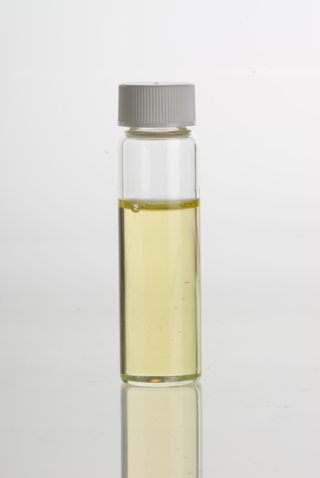
Sesame oil is an edible vegetable oil derived from sesame seeds. The oil is one of the earliest-known crop-based oils. Worldwide mass modern production is limited due to the inefficient manual harvesting process required to extract the oil. Oil made from raw seeds, which may or may not be cold-pressed, is used as a cooking oil. Oil made from toasted seeds is used for its distinctive nutty aroma and taste, although it may be unsuitable for frying, which makes it taste burnt and bitter.
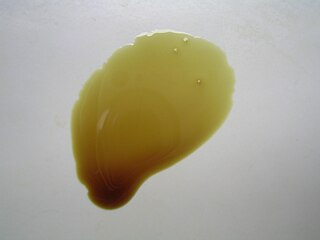
Dichromatism is a phenomenon where a material or solution's hue is dependent on both the concentration of the absorbing substance and the depth or thickness of the medium traversed. In most substances which are not dichromatic, only the brightness and saturation of the colour depend on their concentration and layer thickness.

A pumpkin seed, also known in North America as a pepita, is the edible seed of a pumpkin or certain other cultivars of squash. The seeds are typically flat and oval with one axis of symmetry, have a white outer husk, and are light green in color after the husk is removed. Some pumpkin cultivars are huskless, and are grown only for their edible seed. The seeds are nutrient- and calorie-rich, with an especially high content of fat, protein, dietary fiber, and numerous micronutrients. Pumpkin seed can refer either to the hulled kernel or unhulled whole seed, and most commonly refers to the roasted end product used as a snack.

Egusi (Yoruba) is the name for the protein-rich seeds of certain cucurbitaceous plants, which, after being dried and ground, are used as a major ingredient in West African cuisine.

Cucurbita moschata is a species originating in either Central America or northern South America. It includes cultivars known as squash or pumpkin. C. moschata cultivars are generally more tolerant of hot, humid weather than cultivars of C. maxima or C. pepo. They also generally display a greater resistance to disease and insects, especially to the squash vine borer. Commercially made pumpkin pie mix is most often made from varieties of C. moschata. The ancestral species of the genus Cucurbita were present in the Americas before the arrival of humans. No species within the genus is fully genetically isolated from all the other species. C. moschata can be hybridized with all other species. It has been suggested that this shows that the species of Cucurbita have diversified more recently than those of related genera such as Cucumis and Citrullus.
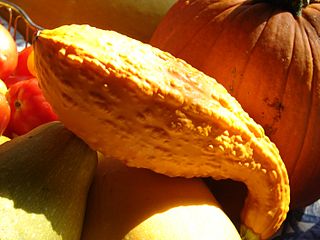
Crookneck squash, also known as yellow squash, is a cultivar of Cucurbita pepo, the species that also includes some pumpkins and most other summer squashes. The plants are bushy and do not spread like the plants of winter squash and pumpkin. Most often used as a summer squash, it is characterized by its yellow skin and sweet yellow flesh, as well as its distinctive curved stem-end or "crooked neck". It should not be confused with crookneck cultivars of Cucurbita moschata, such as the winter squash 'Golden Cushaw', or the vining summer squash 'Tromboncino'. Its name distinguishes it from another similar-looking variety of C. pepo, the straightneck squash, which is also usually yellow. There is one similar non-edible C. pepo variety: C. pepo var. ovifera.
Candlenut oil or kukui nut oil is extracted from the nut of Aleurites moluccanus, the candlenut or kuku'i.
Rose hip seed oil is a pressed seed oil, extracted from the seeds of the wild rose bush Rosa rubiginosa in the southern Andes. Rosehip seed oil can also be extracted from Rosa canina, a wild rose species native to Europe, northwest Africa, and western Asia. The fruits of the rosehip have been used in folk medicine for a long time. Rosehips have prophylactic and therapeutic actions against the common cold, infectious diseases, gastrointestinal disorders, urinary tract diseases, and inflammatory diseases.
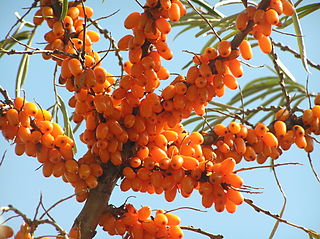
Sea buckthorn oil is a red-orange oil derived from sea buckthorn plants. The most commonly used species for this purpose is Hippophae rhamnoides. Species belonging to this genus accumulate lipids in the mesocarp, so the oil can be extracted from either the seeds or the pulp.

Winter squash is an annual fruit representing several squash species within the genus Cucurbita. Late-growing, less symmetrical, odd-shaped, rough or warty varieties, small to medium in size, but with long-keeping qualities and hard rinds, are usually called winter squash. They differ from summer squash in that they are harvested and eaten in the mature stage when their seeds within have matured fully and their skin has hardened into a tough rind. At this stage, most varieties of this vegetable can be stored for use during the winter. Winter squash is generally cooked before being eaten, and the skin or rind is not usually eaten as it is with summer squash.

A pumpkin is a cultivated winter squash in the genus Cucurbita. The term is most commonly applied to round, orange-colored squash varieties, though it does not possess a scientific definition and may be used in reference to many different squashes of varied appearance.

Kreft's dichromaticity index (DI) is a measure for quantification of dichromatism. It is defined as the difference in hue angle (Δhab) between the color of the sample at the dilution, where the chroma is maximal, and the color of four times more diluted and four times more concentrated sample. The two hue angle differences are called the dichromaticity index towards lighter and dichromaticity index towards darker respectively. Kreft's dichromaticity indexes DIL and DID for pumpkin seed oil, which is one of the most dichromatic substances, are −9 and −44, respectively. This means, that pumpkin seed oil changes its color from green-yellow to orange-red when the thickness of the observed layer is increased from cca 0.5 mm to 2 mm; and it changes slightly towards green if its thickness is reduced for four-fold.
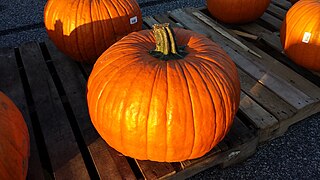
Connecticut field pumpkins are a type of pumpkin first attested in the 16th century. They are one of the oldest varieties of pumpkin in existence and are known as an heirloom plant. One of the most popular Halloween pumpkins, Connecticut field pumpkins are commonly used for autumn decorations and jack-o'-lanterns; a strain of Connecticut field pumpkins have been described as "the original commercial jack-o'-lantern pumpkin". Due to the variety's appearance and growth process, it is considered to be well-suited for ornamental use. It also has culinary uses, particularly in canning, and was used for medicinal purposes by Native Americans in the United States prior to European contact.
The Future 50 Foods report, subtitled "50 foods for healthier people and a healthier planet", was published in February 2019 by the World Wide Fund for Nature (WWF) and Knorr. It identifies 50 plant-based foods that can increase dietary nutritional value and reduce environmental impacts of the food supply, promoting sustainable global food systems.
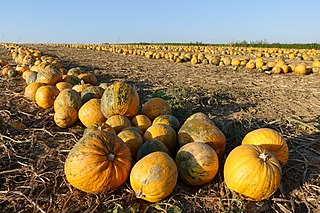
The Styrian oil pumpkin, also known as the Styrian pumpkin, is a variety of the common pumpkin which is cultivated to produce pumpkin seed oil.